Search the Blog
Categories
- Books & Reading
- Broadband Buzz
- Census
- Education & Training
- General
- Grants
- Information Resources
- Library Management
- Nebraska Center for the Book
- Nebraska Libraries on the Web
- Nebraska Memories
- Now hiring @ your library
- Preservation
- Pretty Sweet Tech
- Programming
- Public Library Boards of Trustees
- Public Relations
- Talking Book & Braille Service (TBBS)
- Technology
- Uncategorized
- What's Up Doc / Govdocs
- Youth Services
Archives
Subscribe
Category Archives: What’s Up Doc / Govdocs
2020 Census : Counting Young Children, What You Need to Know
 The 2020 Census: Counting everyone once, only once, and in the right place.
The 2020 Census: Counting everyone once, only once, and in the right place.
An estimated 5% of kids under the age of 5 weren’t counted in the 2010 Census. That’s about 1 million young children, the highest of any age group. We need your help closing this gap in the 2020 Census. The information bulletin below tells us what research has discovered about why young children are missed and what you can do to help make sure they are counted. The information bulletin can be printed out as a handout, or as a poster:
Census 101 : What You Need to Know, in English and Spanish
 The 2020 Census is closer than you think! Here’s a quick refresher of what it is and why it’s essential everyone is counted.
The 2020 Census is closer than you think! Here’s a quick refresher of what it is and why it’s essential everyone is counted.
¡El censo del 2020 está más cerca de lo que piensas! A continuación te damos un
rápido repaso de lo que es y por qué es esencial que todos seamos contados
The information page below can be printed out as a handout or a poster:
Economic Census : What’s New For 2017 Data
The published data from the 2017 Economic Census will reflect many changes from the data that was published in the 2012 Economic Census. These changes mirror the ever-changing U.S. economy, communities, and data user needs. Below is a summary of these key changes and links to more information.
For a list of the data products for the 2017 Economic Census, see the high-level release schedule at: https://www.census.gov/programs-surveys/economic-census/about/release-schedules.html
Geographic Areas
The 2017 Economic Census will publish data to reflect the ever changing geographic areas as of January 2017. Reference materials that highlight the changes from the 2012 Economic Census will be provided on this site, including maps and documents that highlight the changes to:
- Metro Areas – the Core Based Statistical Areas in 15 states had some type of change
- Counties – Alaska, South Dakota, and Virginia had changes to 1 or more counties
- Economic Places – every state had places with area gain, loss, and/or code or name changes. There are 442 new Economic Places being recognized and 171 places that are being dropped for 2017, primarily due to population decline
NAICS
The 2017 Economic Census will be the first Census program to publish data on the 2017 North American Industry Classification System. 6 of the 18 sectors covered by the Economic Census will see changes to the codes published. These changes include:
- One-to-one recodes – industries with no content change but with a code change
- Many-to-one combinations – 2012 NAICS codes that were combined to form a new 2017 code
- Many-to-many combinations – 2 or more 2017 codes that were created from parts of 2 or more 2012 codes
NAPCS
A key offering from the Economic Census are the detailed Product Lines data, which provides a more detailed breakout of the products made and sold and services provided by businesses. These data from the 2012 Economic Census were provided in separate data tables by sector that provided different information. For the 2017 Economic Census, these data are being consolidated and reformatted following the new North American Product Classification System.
Other Changes
The data products from the 2017 Economic Census will include a number of structural and content changes. These include:
- The new “First Look” report – this new report will feature data not available in the initial “Advance Report” release in prior Economic Censuses.
- Consolidated “Size” reports – These data tables which provide detailed breakouts based on the employment and sales/revenue size of establishments or firms were published in separate and disparate tables by sector. For 2017, these tables are being consolidated and standardized across sectors.
- Added and dropped Miscellaneous Subjects reports – 38 tables from the 2012 Economic Census are being dropped, and 7 new tables are being added. Also, the tables showing data by Class of Customer, Enterprise Support, and Exported Services are similarly being consolidated.
- New disclosure rules – In prior Economic Censuses, the number of establishments was published even when the other statistics for an industry and geography were withheld due to disclosure. For 2017, new privacy rules will result in the establishment count being suppressed when less than 3 or when the other statistics are suppressed.
- Local areas published by sector – Place-level data will no longer be available for the Manufacturing sector and the NAICS and geographic levels published for other sectors may be adjusted based on data quality and privacy issues.
- New data.census.gov platform – the data tables from the 2017 Economic Census will be published on this new dissemination platform. Historical data from the 2012 Economic Census will continue to be available on American FactFinder under they are migrated to the new platform.
What’s Up Doc? New State Agency Publications at the Nebraska Library Commission
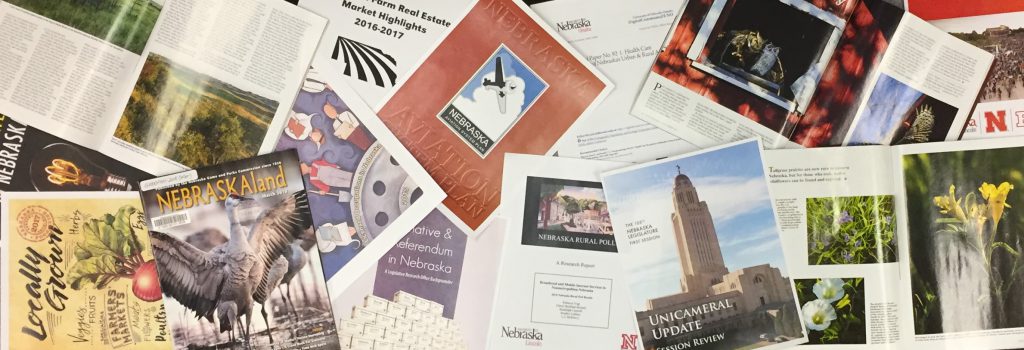 New state agency publications have been received at the Nebraska Library Commission for July 2019. Included are Urban Research Reports from the Center for Applied Urban Research at University of Nebraska–Omaha, reports from the Nebraska Department of Health and Human Services, Legal Aid of Nebraska, Nebraska Department of Natural Resources, and new books from the University of Nebraska Press, to name a few.
New state agency publications have been received at the Nebraska Library Commission for July 2019. Included are Urban Research Reports from the Center for Applied Urban Research at University of Nebraska–Omaha, reports from the Nebraska Department of Health and Human Services, Legal Aid of Nebraska, Nebraska Department of Natural Resources, and new books from the University of Nebraska Press, to name a few.
Most items, except the books from the University of Nebraska Press, are available for immediate viewing and printing by clicking on the highlighted link above, or directly in the .pdf below. You can read synopses of the books received from the University of Nebraska Press books in the July blogpost.
The Nebraska Legislature created the Nebraska Publications Clearinghouse in 1972, a service of the Nebraska Library Commission. Its purpose is to collect, preserve, and provide access to all public information published by Nebraska state agencies. By law (State Statutes 51-411 to 51-413) all Nebraska state agencies are required to submit their published documents to the Clearinghouse. For more information, visit the Nebraska Publications Clearinghouse page, contact Mary Sauers, Government Information Services Librarian; or contact Bonnie Henzel, State Documents Staff Assistant.
Book Briefs: New University of Nebraska Press Books at the Nebraska Publications Clearinghouse
 The Nebraska Publications Clearinghouse receives documents every month from all Nebraska state agencies, including the University of Nebraska Press (UNP). Each month we will be showcasing the UNP books that the Clearinghouse receives. UNP books, as well as all Nebraska state documents, are available for checkout by libraries and librarians, for their patrons, in Nebraska.
The Nebraska Publications Clearinghouse receives documents every month from all Nebraska state agencies, including the University of Nebraska Press (UNP). Each month we will be showcasing the UNP books that the Clearinghouse receives. UNP books, as well as all Nebraska state documents, are available for checkout by libraries and librarians, for their patrons, in Nebraska.
Here are the UNP books the Clearinghouse received in July:
 Art from Trauma : Genocide and Healing Beyond Rwanda Edited and with an introduction by Rangira Bea Gallimore and Gerise Herndon
Art from Trauma : Genocide and Healing Beyond Rwanda Edited and with an introduction by Rangira Bea Gallimore and Gerise Herndon
What is the role of aesthetic expression in responding to discrimination, tragedy, violence, even genocide? How does gender shape responses to both literal and structural violence, including implicit linguistic, familial, and cultural violence? How might writing or other works of art contribute to healing? Art from Trauma: Genocide and Healing beyond Rwanda explores the possibility of art as therapeutic, capable of implementation by mental health practitioners crafting mental health policy in Rwanda.
This anthology of scholarly, personal, and hybrid essays was inspired by scholar and activist Chantal Kalisa (1965–2015). At the commemoration of the nineteenth anniversary of the genocide in Rwanda, organized by the Rwandan Embassy in Washington DC, Kalisa gave a presentation, “Who Speaks for the Survivors of the Genocide against Tutsi?” Kalisa devoted her energy to giving expression to those whose voices had been distorted or silenced. The essays in this anthology address how the production and experience of visual, dramatic, cinematic, and musical arts, in addition to literary arts, contribute to healing from the trauma of mass violence, offering preliminary responses to questions like Kalisa’s and honoring her by continuing the dialogue in which she participated with such passion, sharing the work of scholars and colleagues in genocide studies, gender studies, and francophone literatures.
Give the Word : Responses to Werner Hamacher’s 95 Theses on Philology Edited by Gerhard Richter and Ann Smock (Series: Stages)
Edited by Gerhard Richter and Ann Smock (Series: Stages)
Werner Hamacher’s witty and elliptical 95 Theses on Philology challenges the humanities—and particularly academic philology—that assume language to be a given entity rather than an event. In Give the Word eleven scholars of literature and philosophy (Susan Bernstein, Michèle Cohen-Halimi, Peter Fenves, Sean Gurd, Daniel Heller-Roazen, Jan Plug, Gerhard Richter, Avital Ronell, Thomas Schestag, Ann Smock, and Vincent van Gerven Oei) take up the challenge presented by Hamacher’s theses. At the close Hamacher responds to them in a spirited text that elaborates on the context of his 95 Theses and its rich theoretical and philosophical ramifications.
The 95 Theses, included in this volume, makes this collection a rich resource for the study and practice of “radical philology.” Hamacher’s philology interrupts and transforms, parting with tradition precisely in order to remain faithful to its radical but increasingly occluded core.
The contributors test Hamacher’s break with philology in a variety of ways, attempting a philological practice that does not take language as an object of knowledge, study, or even love. Thus, in responding to Hamacher’s Theses, the authors approach language that, because it can never be an object of any kind, awakens an unfamiliar desire. Taken together these essays problematize philological ontology in a movement toward radical reconceptualizations of labor, action, and historical time.
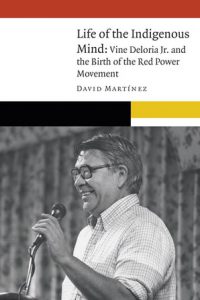 Life of the Indigenous Mind : Vine Deloria Jr. and the Birth of the Red Power Movement David Martinez (Series: New Visions in Native American and Indigenous Studies)
Life of the Indigenous Mind : Vine Deloria Jr. and the Birth of the Red Power Movement David Martinez (Series: New Visions in Native American and Indigenous Studies)
In Life of the Indigenous Mind David Martínez examines the early activism, life, and writings of Vine Deloria Jr. (1933–2005), the most influential indigenous activist and writer of the twentieth century and one of the intellectual architects of the Red Power movement. An experienced activist, administrator, and political analyst, Deloria was motivated to activism and writing by his work as executive director of the National Congress of American Indians, and he came to view discourse on tribal self-determination as the most important objective for making a viable future for tribes.
In this work of both intellectual and activist history, Martínez assesses the early life and legacy of Deloria’s “Red Power Tetralogy,” his most powerful and polemical works: Custer Died for Your Sins (1969), We Talk, You Listen (1970), God Is Red (1973), and Behind the Trail of Broken Treaties (1974). Deloria’s gift for combining sharp political analysis with a cutting sense of humor rattled his adversaries as much as it delighted his growing readership.
Life of the Indigenous Mind reveals how Deloria’s writings addressed Indians and non-Indians alike. It was in the spirit of protest that Deloria famously and infamously confronted the tenets of Christianity, the policies of the Bureau of Indian Affairs, and the theories of anthropology. The concept of tribal self-determination that he initiated both overturned the presumptions of the dominant society, including various “Indian experts,” and asserted that tribes were entitled to the rights of independent sovereign nations in their relationship with the United States, be it legally, politically, culturally, historically, or religiously.
Messianic Fulfillments : Staging Indigenous Salvation in America Hayes Peter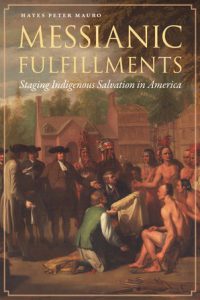 Mauro
Mauro
In Messianic Fulfillments Hayes Peter Mauro examines the role of Christian evangelical movements in shaping American identity in the seventeenth, eighteenth, and nineteenth centuries. Focusing on Christianity’s fervent pursuit of Native American salvation, Mauro discusses Anglo American artists influenced by Christian millenarianism, natural history, and racial science in America. Artists on the colonial, antebellum, and post–Civil War frontier graphically projected their idealization of Christian-based identity onto the bodies of American Indians.
Messianic Fulfillments explores how Puritans, Quakers, Mormons, and members of other Christian millenarian movements viewed Native peoples as childlike, primitive, and in desperate need of Christianization lest they fall into perpetual sin and oblivion and slip into eternal damnation. Christian missionaries were driven by the idea that catastrophic Native American spiritual failure would, in Christ’s eyes, reflect on the shortcomings of those Christians tasked with doing the work of Christian “charity” in the New World.
With an interdisciplinary approach drawing from religious studies and the histories of popular science and art, Messianic Fulfillmentsexplores ethnohistorical encounters in colonial and nineteenth-century America through the lens of artistic works by evangelically inspired Anglo American artists and photographers. Mauro takes a critical look at a variety of visual mediums to illustrate how evangelical imagery influenced definitions of “Americaness,” and how such images reinforced or challenged historically prevailing conceptions of what it means (and looks like) to be American.
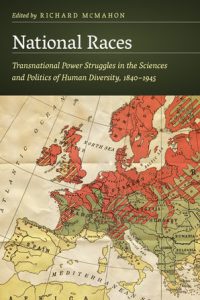 National Races : Transnational Power Struggles in the Sciences and Politics of Human Diversity, 1840-1945 Edited by Richard McMahon (Series: Critical Studies in the History of Anthropology)
National Races : Transnational Power Struggles in the Sciences and Politics of Human Diversity, 1840-1945 Edited by Richard McMahon (Series: Critical Studies in the History of Anthropology)
National Races explores how politics interacted with transnational science in the nineteenth and early twentieth centuries. This interaction produced powerful, racialized national identity discourses whose influence continues to resonate in today’s culture and politics. Ethnologists, anthropologists, and raciologists compared modern physical types with ancient skeletal finds to unearth the deep prehistoric past and true nature of nations. These scientists understood certain physical types to be what Richard McMahon calls “national races,” or the ageless biological essences of nations.
Contributors to this volume address a central tension in anthropological race classification. On one hand, classifiers were nationalists who explicitly or implicitly used race narratives to promote political agendas. Their accounts of prehistoric geopolitics treated “national races” as the proxies of nations in order to legitimize present-day geopolitical positions. On the other hand, the transnational community of race scholars resisted the centrifugal forces of nationalism. Their interdisciplinary project was a vital episode in the development of the social sciences, using biological race classification to explain the history, geography, relationships, and psychologies of nations.
National Races goes to the heart of tensions between nationalism and transnationalism, politics and science, by examining transnational science from the perspective of its peripheries. Contributors to the book supplement the traditional focus of historians on France, Britain, and Germany, with myriad case studies and examples of nineteenth- and early twentieth-century racial and national identities in countries such as Russia, Italy, Poland, Greece, and Yugoslavia, and among Jewish anthropologists.
Place and Postcolonial Ecofeminism : Pakistani Women’s Literary and  Cinematic Fictions Shazia Rahman (Series: Expanding Frontiers : Interdisciplinary Approaches to Studies of Women, Gender, and Sexuality)
Cinematic Fictions Shazia Rahman (Series: Expanding Frontiers : Interdisciplinary Approaches to Studies of Women, Gender, and Sexuality)
While news reports about Pakistan tend to cover Taliban attacks and bombings, and academics focus on security issues, the environment often takes a backseat in media reportage and scholarship. In particular, Pakistani women’s attachment to their environment and their environmental concerns are almost always ignored. Shazia Rahman traces the ways in which Pakistani women explore alternative, environmental modes of belonging, examines the vitality of place-based identities within Pakistani culture, and thereby contributes to evolving understandings of Pakistani women—in relation to both their environment and to various discourses of nation and patriarchy.
Through an astute analysis of such works as Sabiha Sumar’s Khamosh Pani (2003), Mehreen Jabbar’s Ramchand Pakistani (2008), Sorayya Khan’s Noor (2006), Uzma Aslam Khan’s Trespassing (2003), and Kamila Shamsie’s Burnt Shadows (2009), Rahman illuminates how Pakistani women’s creative works portray how people live with one another, deal with their environment, and intuit their relationship with the spiritual. She considers how literary and cinematic documentation of place-based identities simultaneously critiques and counters stereotypes of Pakistan as a country of religious nationalism and oppressive patriarchy. Rahman’s analysis discloses fresh perspectives for thinking about the relationship between social and environmental justice.
 The Virgin of Prince Street : Expeditions into Devotion Sonja Livingston (Series: American Lives)
The Virgin of Prince Street : Expeditions into Devotion Sonja Livingston (Series: American Lives)
With organized religion becoming increasingly divisive and politicized and Americans abandoning their pews in droves, it’s easy to question aspects of traditional spirituality and devotion. In response to this shifting landscape, Sonja Livingston undertakes a variety of expeditions—from a mobile confessional in Cajun Country to a eucharistic procession in Galway, Ireland, to the Death and Marigolds Parade in Albuquerque, New Mexico, and Mass in a county jail on Thanksgiving Day—to better understand devotion in her own life.
The Virgin of Prince Street chronicles her quest, offering an intimate and unusually candid view into Livingston’s relationship with the swiftly changing Catholic Church and into her own changing heart. Ultimately, Livingston’s meditations on quirky rituals and fading traditions thoughtfully and dynamically interrogate traditional elements of sacramental devotion, especially as they relate to concepts of religion, relationships, and the sacred.
Winter 2019 State Publications List Available
For those wanting to add records to their catalogs for Nebraska state documents, the Winter 2019 list of Nebraska E-Docs is now available at http://nlc.nebraska.gov/govdocs/shippinglists/edocsalerts.aspx
Posted in What's Up Doc / Govdocs
Leave a comment
Fall 2018 State Publications List Available
For those wanting to add records to their catalogs for Nebraska state documents, the Fall 2018 list of Nebraska E-Docs is now available at http://nlc.nebraska.gov/govDocs/shippinglists/edocsalerts.aspx
Posted in What's Up Doc / Govdocs
Leave a comment
July 4th Fun Facts–Celebrating 243 Years of Independence!
 As the nation celebrates this Independence Day, it’s a good time to reflect on how our Founding Fathers enshrined in our Constitution the importance of statistics as a vital tool for measuring people, places and economy.
As the nation celebrates this Independence Day, it’s a good time to reflect on how our Founding Fathers enshrined in our Constitution the importance of statistics as a vital tool for measuring people, places and economy.
Who was the first signer of the Declaration of Independence?
Is there a U.S. county named Independence?
What was the nation’s population in 1776?
Answers:
- John Hancock, a merchant by trade, was the first to sign the Declaration of Independence.
- The only county named Independence is in Arkansas.
- The U.S. population was 2.5 million in 1776. It is more than 130 times larger today at 330 million
The following statistics — historical and whimsical — come from responses to U.S. Census Bureau surveys:
- In July 1776, an estimated 2.5 million people lived in the 13 colonies (Series B 12 table below). According to recent projections, there are 330 million residents as of July 1, 2019 (Projections for the United States: 2017-2060, Table 1 below).
- The oldest signer, at age 70, was Benjamin Franklin of Pennsylvania. Franklin County, Pa., had an estimated population of 154,835 on July 1, 2018. There are 24 counties named Franklin in the United States.
- The youngest signer, at age 26, was Edward Rutledge of South Carolina. There are no counties named Rutledge.
- Speaking of county names, there are four counties named Liberty (Florida, Georgia, Montana, Texas) and 18 counties and one parish named Union.
- $368.6 million worth of fireworks were sold in 2012 through establishments classified as NAICS 453998 and all other miscellaneous retailers (except tobacco stores).
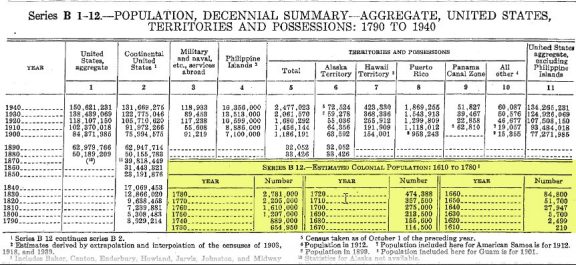
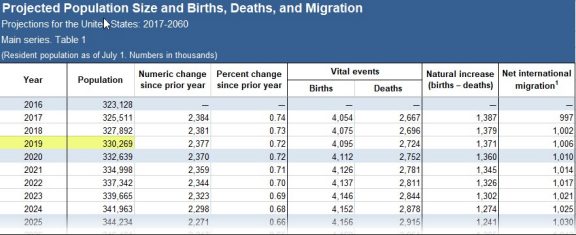
More Fun Facts 
The Census Bureau’s Statistics in Schools program has created this Fun Facts & Teaching Guide for the Fourth of July.
Teachers can interact with students by using fun but real-life data related to the holiday. The teaching guide offers ideas on how to use these facts as an activity.
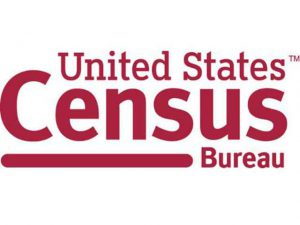
What’s Up Doc? New State Agency Publications at the Nebraska Library Commission
 New state agency publications have been received at the Nebraska Library Commission for June 2019. Included are Annual Reports from the Nebraska Water Center, reports from the Nebraska Planning Council on Developmental Disabilities, Nebraska Department of Health and Human Services, WellCare of Nebraska, Nebraska Environmental Trust Board, Nebraska Department of Education, and new books from the University of Nebraska Press, to name a few.
New state agency publications have been received at the Nebraska Library Commission for June 2019. Included are Annual Reports from the Nebraska Water Center, reports from the Nebraska Planning Council on Developmental Disabilities, Nebraska Department of Health and Human Services, WellCare of Nebraska, Nebraska Environmental Trust Board, Nebraska Department of Education, and new books from the University of Nebraska Press, to name a few.
Most items, except the books from the University of Nebraska Press, are available for immediate viewing and printing by clicking on the highlighted link above, or directly in the .pdf below. You can read synopses of the books received from the University of Nebraska Press books in the June blogpost.
The Nebraska Legislature created the Nebraska Publications Clearinghouse in 1972, a service of the Nebraska Library Commission. Its purpose is to collect, preserve, and provide access to all public information published by Nebraska state agencies. By law (State Statutes 51-411 to 51-413) all Nebraska state agencies are required to submit their published documents to the Clearinghouse. For more information, visit the Nebraska Publications Clearinghouse page, contact Mary Sauers, Government Information Services Librarian; or contact Bonnie Henzel, State Documents Staff Assistant.
Book Briefs: New University of Nebraska Press Books at the Nebraska Publications Clearinghouse
 The Nebraska Publications Clearinghouse receives documents every month from all Nebraska state agencies, including the University of Nebraska Press (UNP). Each month we will be showcasing the UNP books that the Clearinghouse receives. UNP books, as well as all Nebraska state documents, are available for checkout by libraries and librarians, for their patrons, in Nebraska.
The Nebraska Publications Clearinghouse receives documents every month from all Nebraska state agencies, including the University of Nebraska Press (UNP). Each month we will be showcasing the UNP books that the Clearinghouse receives. UNP books, as well as all Nebraska state documents, are available for checkout by libraries and librarians, for their patrons, in Nebraska.
Here are the UNP books the Clearinghouse received in June:
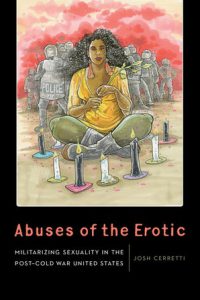 Abuses of the Erotic : Militarizing Sexuality in the Post-Cold War United States Josh Cerretti (Series: Expanding Frontiers–Interdisciplinary Approaches to Studies of Women, Gender, and Sexuality)
Abuses of the Erotic : Militarizing Sexuality in the Post-Cold War United States Josh Cerretti (Series: Expanding Frontiers–Interdisciplinary Approaches to Studies of Women, Gender, and Sexuality)
Events ranging from sexual abuse at Abu Ghraib to the end of “Don’t Ask, Don’t Tell” hint that important issues surrounding gender and sexuality remain at the core of political and cultural problems. Nonetheless, intersectional analyses of militarism that account for questions of race, class, and gender remain exceedingly rare. Abuses of the Erotic fills this gap by offering a comprehensive picture of how military values have permeated the civilian cultural sphere and by investigating connections between sexuality and militarism in the United States since the late 1980s.
Josh Cerretti takes up the urgent task of applying an interdisciplinary, transnational framework to the role of sexuality in promoting, expanding, and sustaining the war on terror to understand the links between what Cerretti calls “domestic militarism” and later projects of state-backed violence and intervention. This work brings together scholarship on domestic and international militarization in relation to both homosexuality and heterosexuality to demonstrate how sexual and gender politics have been deployed to bolster U.S. military policies and, by tracking over a decade of militarized sexuality, how these instances have foundationally changed how we think of sexual and gender politics today.
Apostles of Empire : The Jesuits and New France 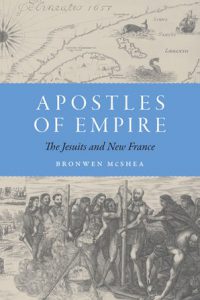 Bronwen McShea (Series: France Overseas–Studies in Empre and Decolonization)
Bronwen McShea (Series: France Overseas–Studies in Empre and Decolonization)
Apostles of Empire is a revisionist history of the French Jesuit mission to indigenous North Americans in the seventeenth and eighteenth centuries, offering a comprehensive view of a transatlantic enterprise in which secular concerns were integral. Between 1611 and 1764, 320 Jesuits were sent from France to North America to serve as missionaries. Most labored in colonial New France, a vast territory comprising eastern Canada and the Great Lakes region that was inhabited by diverse Native American populations. Although committed to spreading Catholic doctrines and rituals and adapting them to diverse indigenous cultures, these missionaries also devoted significant energy to more-worldly concerns, particularly the transatlantic expansion of the absolutist-era Bourbon state and the importation of the culture of elite, urban French society.
In Apostles of Empire Bronwen McShea accounts for these secular dimensions of the mission’s history through candid portraits of Jesuits engaged in a range of secular activities. We see them not only preaching and catechizing in terms that borrowed from indigenous idioms but also cultivating trade and military partnerships between the French and various Indian tribes. Apostles of Empire contributes to ongoing research on the Jesuits, New France, and Atlantic World encounters, as well as on early modern French society, print culture, Catholicism, and imperialism. McShea shows how the Jesuits’ robust conceptions of secular spheres of Christian action informed their efforts from both sides of the Atlantic to build up a French and Catholic empire in North America through significant indigenous cooperation.
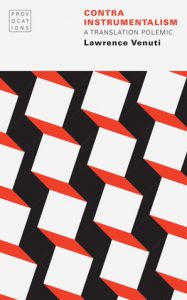
Contra Instrumentalism : a Translation Polemic Lawrence Venuti (Series: Provocations)
Contra Instrumentalism questions the long-accepted notion that translation reproduces or transfers an invariant contained in or caused by the source text. This “instrumental” model of translation has dominated translation theory and commentary for more than two millennia, and its influence can be seen today in elite and popular cultures, in academic institutions and in publishing, in scholarly monographs and in literary journalism, in the most rarefied theoretical discourses and in the most commonly used clichés.
Contra Instrumentalism aims to end the dominance of instrumentalism by showing how it grossly oversimplifies translation practice and fosters an illusion of immediate access to source texts. Lawrence Venuti asserts that all translation is an interpretive act that necessarily entails ethical responsibilities and political commitments. Venuti argues that a hermeneutic model offers a more comprehensive and incisive understanding of translation that enables an appreciation of not only the creative and scholarly aspects of what a translator does but also the crucial role translation plays in the cultural and social institutions that shape human life.
In Defense of Farmers : The Future of Agriculture in the Shadow of Corporate Power Jane W. Gibson and Sara E. Alexander, editors (Series: Our Sustainable Future) 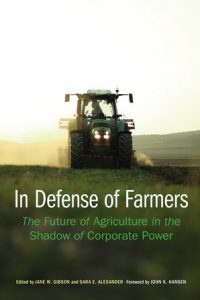
Industrial agriculture is generally characterized as either the salvation of a growing, hungry, global population or as socially and environmentally irresponsible. Despite elements of truth in this polarization, it fails to focus on the particular vulnerabilities and potentials of industrial agriculture. Both representations obscure individual farmers, their families, their communities, and the risks they face from unpredictable local, national, and global conditions: fluctuating and often volatile production costs and crop prices; extreme weather exacerbated by climate change; complicated and changing farm policies; new production technologies and practices; water availability; inflation and debt; and rural community decline. Yet the future of industrial agriculture depends fundamentally on farmers’ decisions.
In Defense of Farmers illuminates anew the critical role that farmers play in the future of agriculture and examines the social, economic, and environmental vulnerabilities of industrial agriculture, as well as its adaptations and evolution. Contextualizing the conversations about agriculture and rural societies within the disciplines of sociology, geography, economics, and anthropology, this volume addresses specific challenges farmers face in four countries: Bolivia, Brazil, Canada, and the United States.
By concentrating on countries with the most sophisticated production technologies capable of producing the largest quantities of grains, soybeans, and animal proteins in the world, this volume focuses attention on the farmers whose labors, decision-making, and risk-taking throw into relief the implications and limitations of our global industrial food system. The case studies here acknowledge the agency of farmers and offer ways forward in the direction of sustainable agriculture.
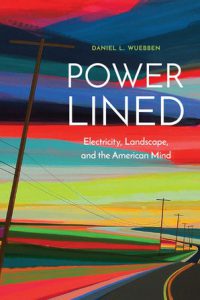 Power Lined : Electricity, Landscape, and the American Mind Daniel L. Wuebben
Power Lined : Electricity, Landscape, and the American Mind Daniel L. Wuebben
The proliferation of electric communication and power networks have drawn wires through American landscapes like vines through untended gardens since 1844. But these wire networks are more than merely the tools and infrastructure required to send electric messages and power between distinct places; the iconic lines themselves send powerful messages. The wiry webs above our heads and the towers rhythmically striding along the horizon symbolize the ambiguous effects of widespread industrialization and the shifting values of electricity and landscape in the American mind.
In Power-Lined Daniel L. Wuebben weaves together personal narrative, historical research, cultural analysis, and social science to provide a sweeping investigation of the varied influence of overhead wires on the American landscape and the American mind. Wuebben shows that overhead wires—from Morse’s telegraph to our high-voltage grid—not only carry electricity between American places but also create electrified spaces that signify and complicate notions of technology, nature, progress, and, most recently, renewable energy infrastructure. Power-Lined exposes the subtle influences wrought by the wiring of the nation and shows that, even in this age of wireless devices, perceptions of overhead lines may be key in progressing toward a more sustainable energy future.
The Supernatural Sublime : The Wondrous Ineffability of the Everyday 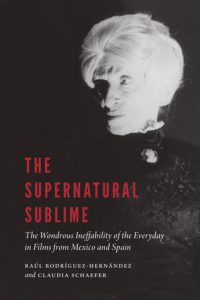 in Films from Mexico and Spain Raul Rodriguez-Hernandez and Claudia Schaefer (Series: New Hispanisms)
in Films from Mexico and Spain Raul Rodriguez-Hernandez and Claudia Schaefer (Series: New Hispanisms)
The Supernatural Sublime explores the long-neglected element of the supernatural in films from Spain and Mexico by focusing on the social and cultural contexts of their production and reception, their adaptations of codes and conventions for characters and plot, and their use of cinematic techniques to create the experience of emotion without explanation. Deploying the overarching concepts of the supernatural and the sublime, Raúl Rodríguez-Hernández and Claudia Schaefer detail the dovetailing of the unnatural and the experience of limitlessness associated with the sublime.
The Supernatural Sublime embeds the films in the social histories of twentieth- and twenty-first-century Mexico and Spain, both of which made a forced leap into modernity after historical periods founded on official ideologies and circumscribed visions of the nation. Evoking Kant’s definition of the experience of the sublime, Rodríguez-Hernández and Schaefer concentrate on the unrepresentable and the contradictory that oppose purported universal truths and instead offer up illusion, deception, and imagination through cinema, itself a type of illusion: writing with light.
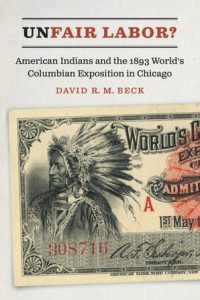 Unfair Labor? : American Indians and the 1893 World’s Columbian Exposition in Chicago David R. M. Beck
Unfair Labor? : American Indians and the 1893 World’s Columbian Exposition in Chicago David R. M. Beck
Unfair Labor? is the first book to explore the economic impact of Native Americans who participated in the 1893 World’s Columbian Exposition held in Chicago. By the late nineteenth century, tribal economic systems across the Americas were decimated, and tribal members were desperate to find ways to support their families and control their own labor. As U.S. federal policies stymied economic development in tribal communities, individual Indians found creative new ways to make a living by participating in the cash economy. Before and during the exposition, American Indians played an astonishingly broad role in both the creation and the collection of materials for the fair, and in a variety of jobs on and off the fairgrounds.
While anthropologists portrayed Indians as a remembrance of the past, the hundreds of Native Americans who participated were carving out new economic pathways. Once the fair opened, Indians from tribes across the United States, as well as other indigenous people, flocked to Chicago. Although they were brought in to serve as displays to fairgoers, they had other motives as well. Once in Chicago they worked to exploit circumstances to their best advantage. Some succeeded; others did not.
Unfair Labor? breaks new ground by telling the stories of individual laborers at the fair, uncovering the roles that Indians played in the changing economic conditions of tribal peoples, and redefining their place in the American socioeconomic landscape.
We Average Unbeautiful Watchers : Fan Narratives and the Reading of 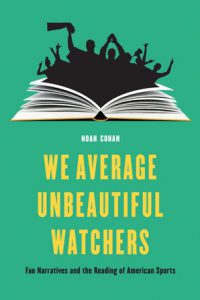 American Sports Noah Cohan (Series: Sports, Media, and Society)
American Sports Noah Cohan (Series: Sports, Media, and Society)
Sports fandom—often more than religious, political, or regional affiliation—determines how millions of Americans define themselves. In We Average Unbeautiful Watchers, Noah Cohan examines contemporary sports culture to show how mass-mediated athletics are in fact richly textured narrative entertainments rather than merely competitive displays. While it may seem that sports narratives are “written” by athletes and journalists, Cohan demonstrates that fans are not passive consumers but rather function as readers and writers who appropriate those narratives and generate their own stories in building their sense of identity.
Critically reading stories of sports fans’ self-definition across genres, from the novel and the memoir to the film and the blog post, We Average Unbeautiful Watchers recovers sports games as sites where fan-authors theorize interpretation, historicity, and narrative itself. Fan stories demonstrate how unscripted sporting entertainments function as identity-building narratives—which, in turn, enhances our understanding of the way we incorporate a broad range of texts into our own life stories.
Building on the work of sports historians, theorists of fan behavior, and critics of American literature, Cohan shows that humanistic methods are urgently needed for developing nuanced critical conversations about athletics. Sports take shape as stories, and it is scholars in the humanities who can best identify how they do so—and why that matters for American culture more broadly.
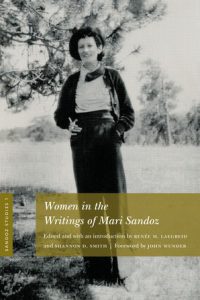 Women in the Writings of Mari Sandoz Edited and with an introduction by Renee M. Laegreid and Shannon D. Smith, Foreword by John Wunder (Series: Sandoz Studies, Volume 1)
Women in the Writings of Mari Sandoz Edited and with an introduction by Renee M. Laegreid and Shannon D. Smith, Foreword by John Wunder (Series: Sandoz Studies, Volume 1)
Mari Sandoz, born on Mirage Flats, south of Hay Springs, Nebraska, on May 11, 1896, was the eldest daughter of Swiss immigrants. She experienced firsthand the difficulties and pleasures of the family’s remote plains existence and early on developed a strong desire to write. Her keen eye for detail combined with meticulous research enabled her to become one of the most valued authorities of her time on the history of the plains and the culture of Native Americans.
Women in the Writings of Mari Sandoz is the first volume of the Sandoz Studies series, a collection of thematically grouped essays that feature writing by and about Mari Sandoz and her work. When Sandoz wrote about the women she knew and studied, she did not shy away from drawing attention to the sacrifices, hardships, and disappointments they endured to forge a life in the harsh plains environment. But she also wrote about moments of joy, friendship, and—for some—a connection to the land that encouraged them to carry on.
The scholarly essays and writings of Sandoz contained in this book help place her work into broader contexts, enriching our understanding of her as an author and as a woman deeply connected to the Sandhills of Nebraska.
Census Bureau Announces 2019 Census Test to Begin
 The U.S. Census Bureau has announced that the 2019 Census Test has begun, as approximately 480,000 housing units across the country receive a questionnaire testing the operational effects of including a citizenship question on the 2020 Census. The 2019 Census Test will randomly assign households to two panels and ask them to respond to the 2020 Census questions. Panel A will include the question on citizenship, Panel B will not. Findings from the nationwide test will assist in determining updates to 2020 Census operations, such as how many census takers are needed to follow up with nonresponding households and how to better communicate with households about the 2020 Census.
The U.S. Census Bureau has announced that the 2019 Census Test has begun, as approximately 480,000 housing units across the country receive a questionnaire testing the operational effects of including a citizenship question on the 2020 Census. The 2019 Census Test will randomly assign households to two panels and ask them to respond to the 2020 Census questions. Panel A will include the question on citizenship, Panel B will not. Findings from the nationwide test will assist in determining updates to 2020 Census operations, such as how many census takers are needed to follow up with nonresponding households and how to better communicate with households about the 2020 Census.
Posted in Census, Education & Training, General, Information Resources, Technology, Uncategorized, What's Up Doc / Govdocs
Tagged census
Leave a comment
The Public Library’s Role during Elections: Voter Education in the Age of Misinformation
 In a time marked by uncertainty, the public library is in an extraordinary position as one of society’s most trusted institutions. Public libraries can leverage that trust to be at the forefront of voter education as we head into what will be one of the most watched presidential elections of our lifetimes.
In a time marked by uncertainty, the public library is in an extraordinary position as one of society’s most trusted institutions. Public libraries can leverage that trust to be at the forefront of voter education as we head into what will be one of the most watched presidential elections of our lifetimes.
This presentation will equip librarians to gather user-friendly information from reliable and nonpartisan sources, allowing libraries to offer an invaluable, evolving resource tailor-made for their communities. By exploring resources—everything from a glossary of common terms used during elections to campaign finance information—this webinar will help librarians gather the most useful information in addressing their community’s needs. With a focus on citizenship and voting, librarians will learn to serve their diverse populations in a nonthreatening and nonpartisan way. REGISTER NOW
Date: Tuesday, Jun. 4, 2019
Time: 1:00–2:00 p.m. Central Time
Learning Outcomes
At the conclusion of this webinar, participants will be able to:
• Identify the information needs of their communities regarding elections and voter mobilization efforts;
• Identify key stakeholders and audiences to whom they will communicate the importance of their voter education efforts; and
• Curate and design a helpful online resource equipping their communities to be engaged in the voting process.
Presenters:
Haley Samuelson is reference librarian at the Cook Memorial Public Library District serving Lake County, IL. With more than 15 years’ experience in libraries, Haley has worked with patrons of all ages. She also has experience working in at-risk neighborhoods on Chicago’s West Side. Since 2016, she has enjoyed marrying her background in politics with the information needs of her community.
Nate Gass is webmaster and emerging technology librarian at the Cook Memorial Public Library District serving Lake County, IL. In addition to maintaining the library’s website, he has eight years’ experience teaching computer classes and technology topics. Nate also hosts and produces the Cook Memorial Public Library Podcast (https://cooklib.org/podcast) and is a member of the library’s social media team.
Registration Details
Date: Tuesday, Jun. 4, 2019
Time: 1:00–2:00 p.m. Central Time
Cost: The webinar is free, but registration is required. You can register for this webinar until it begins, or until space is no longer available, whichever comes first.
Libraries’ Guide to the 2020 Census
 The American Library Association has released the Libraries’ Guide to the 2020 Census, a new resource to prepare libraries for the decennial count of every person living in the United States.
The American Library Association has released the Libraries’ Guide to the 2020 Census, a new resource to prepare libraries for the decennial count of every person living in the United States.
The Guide contains practical information to assist library staff in addressing potential patron and community requests regarding the upcoming 2020 Census. The Guide includes:
• basic information about the Census process;
• highlights of new components in the 2020 Census, such as the online response option;
• frequently asked questions;
• a timeline of key Census dates;
• contact information and links to additional resources.
ALA teamed with the Georgetown Center on Poverty and Inequality to develop the Guide, with support from ALA’s 2020 Census Library Outreach and Education Task Force. ALA plans to provide additional resources for library practitioners in the months leading up to Census Day on April 1, 2020.
The Libraries’ Guide to the 2020 Census is available for free download at ala.org/census.
What’s Up Doc? New State Agency Publications at the Nebraska Library Commission
 New state agency publications have been received at the Nebraska Library Commission for May 2019. Included are Audit Reports from the Nebraska Auditor of Public Accounts, reports from the Nebraska Department of Corrections, Nebraska Department of Economic Development, Nebraska Foster Care Review Office, the Nebraska Public Power District, Urban Research Reports from the University of Nebraska at Omaha–Center for Public Affairs Research, and new books from the University of Nebraska Press, to name a few.
New state agency publications have been received at the Nebraska Library Commission for May 2019. Included are Audit Reports from the Nebraska Auditor of Public Accounts, reports from the Nebraska Department of Corrections, Nebraska Department of Economic Development, Nebraska Foster Care Review Office, the Nebraska Public Power District, Urban Research Reports from the University of Nebraska at Omaha–Center for Public Affairs Research, and new books from the University of Nebraska Press, to name a few.
Most items, except the books from the University of Nebraska Press, are available for immediate viewing and printing by clicking on the highlighted link above, or directly in the .pdf below. You can read synopses of the books received from the University of Nebraska Press books in the May blogpost.
The Nebraska Legislature created the Nebraska Publications Clearinghouse in 1972, a service of the Nebraska Library Commission. Its purpose is to collect, preserve, and provide access to all public information published by Nebraska state agencies. By law (State Statutes 51-411 to 51-413) all Nebraska state agencies are required to submit their published documents to the Clearinghouse. For more information, visit the Nebraska Publications Clearinghouse page, contact Mary Sauers, Government Information Services Librarian; or contact Bonnie Henzel, State Documents Staff Assistant.
NASA MAKES THEIR ENTIRE MEDIA LIBRARY PUBLICLY ACCESSIBLE AND COPYRIGHT FREE
 No matter if you enjoy taking or just watching images of space, NASA has a treat for you. They have made their entire collection of images, sounds, and video available and publicly searchable online. It’s 140,000 photos and other resources available for you to see, or even download and use it any way you like.
No matter if you enjoy taking or just watching images of space, NASA has a treat for you. They have made their entire collection of images, sounds, and video available and publicly searchable online. It’s 140,000 photos and other resources available for you to see, or even download and use it any way you like.
You can type in the term you want to search for and browse through the database of stunning images of outer space. Additionally, there are also images of astronauts, rocket launches, events at NASA and other interesting stuff. What’s also interesting is that almost every image comes with the EXIF data, which could be useful for astrophotography enthusiasts.
When you browse through the gallery, you can choose to see images, videos or audio.  Another cool feature I noticed is that you can narrow down the results by the year. Of course, I used some of my time today to browse through the gallery, and here are some of the space photos you can find:
Another cool feature I noticed is that you can narrow down the results by the year. Of course, I used some of my time today to browse through the gallery, and here are some of the space photos you can find:
 What I love about NASA is that they make interesting content for average Internet users. They make us feel closer and more familiar with their work and with the secrets of the outer space. For instance, they recently launched a GIPHY account full of awesome animated gifs. It’s also great that photography is an important part of their missions, and so it was even before “pics or it didn’t happen” became the rule. The vast media library they have now published is available to everyone, free of charge and free of copyright. Therefore, you can take a peek at the fascinating mysteries of space, check out what it’s like inside NASA’s premises, or download the images to make something awesome from them. Either way, you’ll enjoy it!
What I love about NASA is that they make interesting content for average Internet users. They make us feel closer and more familiar with their work and with the secrets of the outer space. For instance, they recently launched a GIPHY account full of awesome animated gifs. It’s also great that photography is an important part of their missions, and so it was even before “pics or it didn’t happen” became the rule. The vast media library they have now published is available to everyone, free of charge and free of copyright. Therefore, you can take a peek at the fascinating mysteries of space, check out what it’s like inside NASA’s premises, or download the images to make something awesome from them. Either way, you’ll enjoy it!
Courtesy of
THIS WEEK: Saving Your Family Treasures Workshop
 Saving Your Family Treasures Workshop is a workshop that provides information on how to preserve damaged personal heirlooms after natural disasters. The workshop is free and open to the public.
Saving Your Family Treasures Workshop is a workshop that provides information on how to preserve damaged personal heirlooms after natural disasters. The workshop is free and open to the public.
Saturday, June 1, 2019: 10:30 am – 12:00 noon CST
The Durham Museum
801 South 10th Street
Omaha, NE 68108
When homes are flooded and lives upended, treasured possessions such as family heirlooms, photos, and other keepsakes become more cherished. Even in the aftermath of a disaster, these treasures may be salvageable. Smithsonian affiliate The Durham Museum has teamed up with the Smithsonian Cultural Rescue Initiative to host a second free workshop providing information on how to preserve damaged personal heirlooms after natural disasters.
Experts will demonstrate how to handle, dry, and clean damaged objects and share tips on personal safety, setting priorities, and other preservation options. There will be a formal presentation followed by a question and answer period.
The workshop will have examples of common personal heirlooms on display to demonstrate salvaging techniques. ***DUE TO SAFETY CONCERNS*** please do not bring your damaged objects to the workshop. If you have specific questions about your personal heirlooms, feel free to bring images of each item to discuss with the preservation experts directly.
THIS WEEK: Training Seminar for Cultural Heritage Professionals
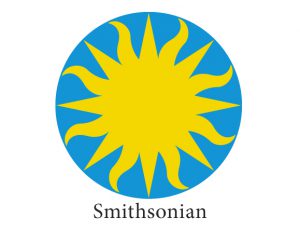 Cultural heritage professionals from across the region are invited for a training workshop for post‐disaster community engagement.
Cultural heritage professionals from across the region are invited for a training workshop for post‐disaster community engagement.
“Strategies for Post-Disaster Community Engagement Workshop”
When homes are damaged and lives are upended, treasured keepsakes such as artwork, photos, personal papers, and other family heirlooms become more cherished. Even in the aftermath of a disaster, these treasures may be salvageable. Cultural institutions can provide important information to communities to preserve their possessions as they regain access to their homes and businesses. On May 31, the Smithsonian Institution’s experts will be onsite and online at The Durham Museum to provide a workshop exclusively for cultural heritage professionals. They will conduct a “train‐the-trainer”
session with the hope that institutions will host workshops in their own communities to most directly help those recovering from the recent historic flooding.
Friday, May 31 from 1:00 p.m. – 3:00 p.m. CST
The Durham Museum
Criss Conference Center,
801 S. 10th Street,
Omaha, NE
The workshop will be live-streamed through ZOOM video-conference software for those unable to attend onsite.
Presented by The Smithsonian Cultural Rescue Initiative, in collaboration with The Durham Museum in Omaha.
Register by emailing Carrie Meyer at cmeyer@durhammuseum.org and indicate ZOOM or onsite participation.
Book Briefs: New University of Nebraska Press Books at the Nebraska Publications Clearinghouse

The Nebraska Publications Clearinghouse receives documents every month from all Nebraska state agencies, including the University of Nebraska Press (UNP). Each month we will be showcasing the UNP books that the Clearinghouse receives. UNP books, as well as all Nebraska state documents, are available for checkout by libraries and librarians, for their patrons, in Nebraska.
Here are the UNP books the Clearinghouse received in May:
 Age in Love : Shakespeare and the Elizabethan Court Jacqueline Vanhoutte (Series: Early Modern Cultural Studies)
Age in Love : Shakespeare and the Elizabethan Court Jacqueline Vanhoutte (Series: Early Modern Cultural Studies)
The title Age in Love is taken from Shakespeare’s sonnet 138, a poem about an aging male speaker who, by virtue of his entanglement with the dark lady, “vainly” performs the role of “some untutor’d youth.” Jacqueline Vanhoutte argues that this pattern of “age in love” pervades Shakespeare’s mature works, informing his experiments in all the dramatic genres. Bottom, Malvolio, Claudius, Falstaff, and Antony all share with the sonnet speaker a tendency to flout generational decorum by assuming the role of the lover, normally reserved in Renaissance culture for young men. Hybrids and upstarts, cross-dressers and shape-shifters, comic butts and tragic heroes—Shakespeare’s old-men-in-love turn in boundary-blurring performances that probe the gendered and generational categories by which early modern subjects conceived of identity.
In Age in Love Vanhoutte shows that questions we have come to regard as quintessentially Shakespearean—about the limits of social mobility, the nature of political authority, the transformative powers of the theater, the vagaries of human memory, or the possibility of secular immortality—come to indelible expression through Shakespeare’s artful deployment of the “age in love” trope. Age in Love contributes to the ongoing debate about the emergence of a Tudor public sphere, building on the current interest in premodern constructions of aging and ultimately demonstrating that the Elizabethan court shaped Shakespeare’s plays in unexpected and previously undocumented ways.
Great Plains Weather Kenneth F. Dewey (Series: Discover the Great Plains)
The weather of the Great Plains is extreme and highly variable, from floods to droughts, blizzards to tornadoes. In Great Plains WeatherKenneth F. Dewey explains what makes this region’s climate unique by presenting a historical climatology of extreme weather events. Beginning with tornadoes—perhaps the most formidable plains weather phenomena—he describes the climatology of these storms and discusses memorable tornadoes of the plains. As one of the storm chasers who travels the Great Plains in the spring and summer tracking severe weather, Dewey also shares some of his experiences on the road.
Dewey then goes on to discuss famous blizzards, from the “School Children’s Storm” of 1888 to more recent storms, along with droughts and floods. Precipitation, or the lack thereof, has long determined human activity in the region; exacerbated by the vagaries of climate change, it continues to have a significant economic and cultural impact on the people of the plains. Dewey’s absorbing narrative is complemented by images of tornadoes, snowstorms, and flash floods that he amassed in forty years of climatological research.
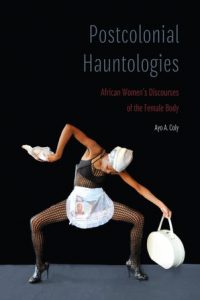 Postcolonial Hauntologies : African Women’s Discourses of the Female Body Ayo A. Coly (Series: Expanding Frontiers–Interdisciplinary Approaches to Studies of Women, Gender, and Sexuality)
Postcolonial Hauntologies : African Women’s Discourses of the Female Body Ayo A. Coly (Series: Expanding Frontiers–Interdisciplinary Approaches to Studies of Women, Gender, and Sexuality)
Postcolonial Hauntologies is an interdisciplinary and comparative analysis of critical, literary, visual, and performance texts by women from different parts of Africa. While contemporary critical thought and feminist theory have largely integrated the sexual female body into their disciplines, colonial representations of African women’s sexuality “haunt” contemporary postcolonial African scholarship which—by maintaining a culture of avoidance about women’s sexuality—generates a discursive conscription that ultimately holds the female body hostage. Ayo A. Coly employs the concept of “hauntology” and “ghostly matters” to formulate an explicative framework in which to examine postcolonial silences surrounding the African female body as well as a theoretical framework for discerning the elusive and cautious presences of female sexuality in the texts of African women.
In illuminating the pervasive silence about the sexual female body in postcolonial African scholarship, Postcolonial Hauntologieschallenges hostile responses to critical and artistic voices that suggest the African female body represents sacred ideological-discursive ground on which one treads carefully, if at all. Coly demonstrates how “ghosts” from the colonial past are countered by discursive engagements with explicit representations of women’s sexuality and bodies that emphasize African women’s power and autonomy.
Songs of Profit, Songs of Loss : Private Equity, Wealth, and Inequality 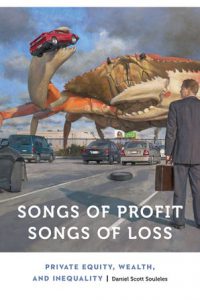 Daniel Scott Souleles (Series: Anthropology of Contemporary North America)
Daniel Scott Souleles (Series: Anthropology of Contemporary North America)
Since the early 1980s, private equity investors have heralded and shepherded massive changes in American capitalism. From outsourcing to excessive debt taking, private equity investment helped normalize once-taboo business strategies while growing into an over $3 trillion industry in control of thousands of companies and millions of workers. Daniel Scott Souleles opens a window into the rarefied world of private equity investing through ethnographic fieldwork on private equity financiers. Songs of Profit, Songs of Loss documents how and why investors buy, manage, and sell the companies that they do; presents the ins and outs of private equity deals, management, and valuation; and explains the historical context that gave rise to private equity and other forms of investor-led capitalism.
In addition to providing invaluable ethnographic insight, Songs of Profit, Songs of Loss is also an anthropological study of inequality as Souleles connects the core components of financial capitalism to economic disparities. Souleles uses local ideas of “value” and “time” to frame the ways private equity investors comprehend their work and to show how they justify the prosperity and poverty they create. Throughout, Souleles argues that understanding private equity investors as contrasted with others in society writ large is essential to fully understanding private equity within the larger context of capitalism in the United States.
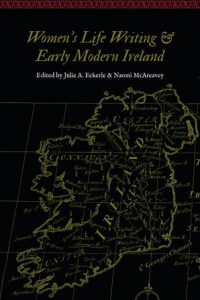 Women’s Life Writing & Early Modern Ireland Edited by Julie A Eckerle & Naomi McAreavey (Series: Women and Gender in the Early Modern World)
Women’s Life Writing & Early Modern Ireland Edited by Julie A Eckerle & Naomi McAreavey (Series: Women and Gender in the Early Modern World)
Women’s Life Writing and Early Modern Ireland provides an original perspective on both new and familiar texts in this first critical collection to focus on seventeenth-century women’s life writing in a specifically Irish context. By shifting the focus away from England—even though many of these writers would have identified themselves as English—and making Ireland and Irishness the focus of their essays, the contributors resituate women’s narratives in a powerful and revealing landscape.
This volume addresses a range of genres, from letters to book marginalia, and a number of different women, from now-canonical life writers such as Mary Rich and Ann Fanshawe to far less familiar figures such as Eliza Blennerhassett and the correspondents and supplicants of William King, archbishop of Dublin. The writings of the Boyle sisters and the Duchess of Ormonde—women from the two most important families in seventeenth-century Ireland—also receive a thorough analysis. These innovative and nuanced scholarly considerations of the powerful influence of Ireland on these writers’ construction of self, provide fresh, illuminating insights into both their writing and their broader cultural context.
FREE PLA Webinar : Measuring the Success of Health Programs and Services
![]() Public libraries are critical to their community’s health, serving as a go-to resource for individuals to access current and reliable health information. Public library staff have a deep understanding of the unique needs of their communities and the value of serving their patrons’ health needs. Now all they need is the data to prove just how valuable those services are. In this webinar, participants will learn how Project Outcome’s new health survey will help public libraries measure the success of health programs and services. Participants will also discover helpful resources and training tools to enhance their health services. REGISTER NOW!
Public libraries are critical to their community’s health, serving as a go-to resource for individuals to access current and reliable health information. Public library staff have a deep understanding of the unique needs of their communities and the value of serving their patrons’ health needs. Now all they need is the data to prove just how valuable those services are. In this webinar, participants will learn how Project Outcome’s new health survey will help public libraries measure the success of health programs and services. Participants will also discover helpful resources and training tools to enhance their health services. REGISTER NOW!
The Project Outcome health survey was developed in partnership with the National Network of Libraries of Medicine (NNLM), dedicated to advancing the progress of medicine and improving public health. To learn more, visit https://nnlm.gov/.
At the conclusion of this webinar, participants will:
- Know resources and training tools to help create and improve health services at their library;
- Understand how to measure the outcomes of their health-related programs using Project Outcome’s new health survey; and,
- Be able to apply survey data for decision making and action.
Presenter:
Emily Plagman, manager of impact and advocacy, manages PLA’s performance measurement initiative, Project Outcome. Prior to joining PLA, Emily worked as a project manager at the Chicago Metropolitan Agency for Planning on an energy efficiency grant. Emily received her Master’s in International Public Affairs from the LaFollette School of Public Affairs at the University of Wisconsin and her Bachelor’s in Political Science at Marquette University.
REGISTRATION DETAILS:
Date: Wednesday, May 29, 2019
Time: 1:00–2:00 p.m. Central Time
Cost: The webinar is free, but registration is required. You can register for this webinar until it begins, or until space is no longer available, whichever comes first.
2020 Census: Key Roles for Libraries
 In 2020, the Census will be conducted primarily online for the first time. Like past e-government efforts, this will likely impact libraries and libraries’ technology resources as staff work to assist people in participating in the Census. The 2020 Census also presents an opportunity to increase public awareness and use of Census data. To best position libraries to support our communities in the 2020 Census, ALA is engaging with the Census Bureau and other stakeholders to ensure that libraries are informed and represented in the policy discussions and planning process. ALA is advocating for a fair, accurate, and inclusive Census that recognizes the roles libraries will play in this vital civic effort.
In 2020, the Census will be conducted primarily online for the first time. Like past e-government efforts, this will likely impact libraries and libraries’ technology resources as staff work to assist people in participating in the Census. The 2020 Census also presents an opportunity to increase public awareness and use of Census data. To best position libraries to support our communities in the 2020 Census, ALA is engaging with the Census Bureau and other stakeholders to ensure that libraries are informed and represented in the policy discussions and planning process. ALA is advocating for a fair, accurate, and inclusive Census that recognizes the roles libraries will play in this vital civic effort.
Want to stay up-to-date on our work to prepare for the 2020 Census? Subscribe to ALA’s Census newsletter.
Why the Census is Important
- Representation: The decennial count of all U.S. residents is required by the U.S. Constitution to determine representation in Congress and the Electoral College (known as reapportionment). This data is also the basis for drawing districts for federal, state, and local offices (known as redistricting).
- Funding: The Census is key to the allocation of billions of dollars in federal funding to states and localities (such as grants to states under the Library Services and Technology Act).
- Information: Data resulting from the Census is widely used by researchers, governments, businesses, and other organizations (to, for example, plan for library services).
Key Roles for Libraries
- Partners in E-Government: In 2020, the Census Bureau for the first time will encourage residents to complete the Census questionnaire online, starting in March 2020. Like past e-government efforts, this likely will place additional demands on library staff and technology resources to enable people to complete the Census questionnaire. (Other response methods will also be available.) Libraries can use their experience partnering with government to assist their communities in achieving a fair, accurate, and inclusive count.
- Education and Community Outreach: Libraries have the opportunity to educate their communities about the Census. In the 2010 Census, more than 6,000 library locations hosted Census Bureau outreach activities.
- Public Spaces: Census Bureau field staff often utilize community rooms in libraries as affordable temporary workspaces, such as for staff hiring and training. Other community stakeholders may also use library meeting rooms to host events related to the 2020 Census.
Advocacy for a Fair, Accurate, and Inclusive Census
- Coalition letter regarding to the Commerce, Justice, Science, and Related Agencies Appropriations subcommittees regarding FY2020 funding for the Census Bureau (April 16, 2019
- Testimony to the House Commerce Appropriations Subcommittee regarding funding for the 2020 Census (April 4, 2019)
- The Scoop: “ALA Joins Group Opposing Census Citizenship Question: Supreme Court Argument will be Heard April 23.” (April 2, 2019)
- Amicus curiae brief of ALA, et al., in the Supreme Court of the United States, Department of Commerce v. State of New York, regarding a citizenship question on the 2020 Census (April 1, 2019)
- Coalition letter to the U.S. Census Bureau on recommendations for Questionnaire Assistance Centers for the 2020 Census (March 19, 2019)
- Washington Hotline: “Libraries Can Ensure Everyone Counts in 2020 Census” (February, 2019)
- Letter to the U.S. Census Bureau regarding Questionnaire Assistance Centers for the 2020 Census (February 22, 2019)
- The Scoop: “Census Resources for Libraries: Help Achieve a Complete Count in 2020.” (January 15, 2019)
- Letter to the House and Senate Appropriations Committees urging funding for Questionnaire Assistance Centers in the 2020 Census (December 7, 2018)
- The Scoop: “Libraries and the 2020 Census: Workshops Prepare Librarians for Taking a Complete Count.” (October 30, 2018)
- The Scoop: “Getting Ready for the 2020 Census: Partnering with Complete Count Committees.” (September 11, 2018)
- The Scoop: “ALA Urges Commerce Department to Reject Census Citizenship Question.” (August 9, 2018)
- Comments to the Census Bureau regarding information collection in the 2020 Census (August 6, 2018)
- Coalition comments to the Census Bureau regarding information collection in the 2020 Census (August 1, 2018)
- Coalition Letter to the Senate Commerce, Justice, Science Appropriations Subcommittee regarding FY 2019 funding for the Census Bureau (June 4, 2018)
- District Dispatch: Gearing up for the 2020 Census (April 4, 2018)
- Coalition Letter to the House and Senate Commerce, Justice, Science Appropriations Subcommittees regarding FY 19 funding for the Census Bureau (May 1, 2018)
- Coalition Letters to the House Committee on Oversight and Government Reform and Senate Committee on Homeland Security and Governmental Affairs regarding a citizenship question on the 2020 Census (April 12, 2018)
- Coalition Letter to the Commerce Department opposing the addition of a citizenship question to the 2020 Census (January 10, 2018)
Learn More
- 2020 Census Technology FAQs – frequently asked technical and security questions regarding the 2020 census (CensusCounts.org)
- 2020 Census (U.S. Census Bureau)
- 2020 Census Operational Timeline (U.S. Census Bureau)
- Complete Count Committees (U.S. Census Bureau)
- Census Regional Offices – to contact the Census Bureau staff in your community (U.S. Census Bureau)
- Counting Everyone in the Digital Age: The Implications of Technology Use in the 2020 Decennial Census for the Count of Disadvantaged Groups (Leadership Conference Education Fund and Georgetown Center on Poverty and Inequality, Fall 2017)
- Census 2020 Hard to Count Map (City University of New York Center for Urban Research)
- Public libraries across the United States are planning to play an active role in the 2020 Census (City University of New York Center for Urban Research)
Courtesy of the American Library Association: http://www.ala.org/advocacy/govinfo/census


